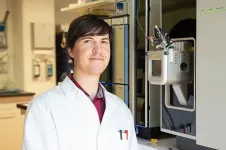(Press-News.org) Greater Helsinki -- Transitioning to low-carbon energy production is the biggest climate challenge to overcome. Many countries are already looking to adopt clean heating solutions more widely, with the International Energy Agency projecting that by 2045 nearly half of global heating will be done with heat pumps. To ensure speedy uptake, governments are likely to offer subsidies to ensure these energy-efficient options actually make their way into homes and offices.
A new study from Aalto University assesses the impact of heat pumps on energy consumption as well as how heat pumps should be subsidised. These devices run on electricity to warm spaces by efficiently transferring heat from one area to another, cutting buildings' carbon footprints significantly.
'My research shows that a heat pump can reduce carbon dioxide emissions from heating by more than 80 percent. Electrifying heating means we can warm our homes and buildings cleanly. Heat pumps are also truly energy-efficient: they can can produce up to four units of heat for every unit of electricity,' says Jussi Vimpari, a post-doctoral researcher at Aalto University.
In the study, Vimpari compares the prices, rents, heating systems, and emissions from heating, and the percentage of residents' income spent on heating in all residential buildings in eight large Finnish cities, including those in the capital region of Helsinki. In Finland, city buildings are typically heated with oil, district heating, or electricity. Only 15% of heating in the country is currently done with heat pumps.
An average of about 9 percent of household income was spent on heating and installing a heat pump reduced this to roughly 4 percent. The investment required for the pump was an average of €3,800 per resident, unsubsidised, with the cost recouped through lower heating in just over ten years. In Finland, the cost of the unit and its installation is subsidised up to 25-50 percent.
The findings also show that neighbourhoods with lower housing prices are less motivated -- and likely less able -- to invest in heat pumps.
'In areas with high prices, the cost of the heat pump is just a small fraction of the overall cost of the home, around one percent. But in areas where homes are valued at lower prices, the relative cost of the device seems to be too large to invest,' Vimpari explains.
This division in purchase habits means subsidies are going to areas where homeowners are likely to buy the device -- even without the monetary incentive. Vimpari says potential subsidies should be allocated to those who would benefit the most.
'When the cost of the heat pump amounts to a larger percent of the cost of the home, the owner has less motivation and capability to make the investment. This may be especially true because income correlates with housing prices: owners may want to heat their homes more efficiently, but just cannot afford the upfront cost. If governments want to help citizens transition to clean energy, they need to think about those who need the benefits most,' says Vimpari.
Some countries like the United States or Germany still rely mainly on gas boilers for heating, as fuel still costs less than electricity in these markets. The European Union, however, has discussed banning gas boilers in new buildings in efforts to move away from fossil fuels; member nations like Finland promote heat pumps for their energy-efficiency, while neighbouring Sweden spurred sales of the device when they introduced tax on heating oil in the 1990s.
'Eventually all heating has to become non-fussil fuel based. Currently, the electrification of heating with heat pumps looks like the most efficient way to do this, as we have the means to produce emission-free electricity and heat pumps can convert that electricity to heat with very high efficiencies,' Vimpari notes.
INFORMATION:
Research published in the journal ACS Materials and Interfaces has provided new understanding of how false-negative results in Lateral Flow Tests occur and provides opportunity for simple improvements to be made.
Lateral Flow Devices were introduced late in 2020 on a global scale to help detect novel coronavirus infection in individuals, with test results produced rapidly in half an hour or less. However, their potential has been somewhat hindered by inadequate sensitivity, with a high number of false-negative results.
Using X-ray fluorescence imaging from Diamond Light Source, researchers from King's College London ...
Researchers from the University of Kent's School of Psychology have found that when people are presented with the idea of a Covid-19 "immunity passport", they show less willingness to follow social distancing and face covering guidelines. However, this willingness seems to return when people read more cautious information about Covid-19 immunity.
PhD students Ricky Green and Mikey Biddlestone and Professor Karen Douglas asked participants from the UK and USA to imagine they had either recovered from Covid-19 or were currently infected. Participants asked to imagine ...
Several different causes of ageing have been discovered, but the question remains whether there are common underlying mechanisms that determine ageing and lifespan. Researchers from the Max Planck Institute for Biology of Ageing and the CECAD Cluster of Excellence in Ageing research at the University Cologne have now come across folate metabolism in their search for such basic mechanisms. Its regulation underlies many known ageing signalling pathways and leads to longevity. This may provide a new possibility to broadly improve human health during ageing.
In recent decades, ...
In an international study published by the journal Environment International, the University of Surrey led an international team of air pollution experts in monitoring pollution hotspots in 10 global cities: Dhaka (Bangladesh); São Paulo (Brazil); Guangzhou (China); Medellín (Colombia); Cairo (Egypt); Addis Ababa (Ethiopia); Chennai (India); Sulaymaniyah (Iraq); Blantyre (Malawi); and Dar-es-Salaam (Tanzania).
Surrey's Global Centre for Clean Air Research (GCARE) set out to investigate whether the amount of fine air pollution particles (PM2.5) drivers inhaled is connected to the duration drivers spend in pollution hotspots and socio-economic indicators such ...
2 June 2021, Singapore - The human fetal immune system begins to develop early during gestation, however, factors responsible for fetal immune-priming remain elusive. Using multiple complementary approaches, Dr Florent Ginhoux from A*STAR's Singapore Immunology Network (SIgN), Professor Jerry Chan from KK Women's and Children's Hospital (KKH), Professor Salvatore Albani from the SingHealth Duke-NUS Translational Immunology Institute, with collaborators from Cambridge University explored potential exposure to microbial agents in-utero. The team identified live microbes across fetal organs that stimulate activation of fetal T-cells during the second trimester of gestation. Study published in scientific journal, Cell, on 24 June 2021.
The team profiled microbes ...
Do you like the thick brush strokes and soft color palettes of an impressionist painting such as those by Claude Monet? Or do you prefer the bold colors and abstract shapes of a Rothko? Individual art tastes have a certain mystique to them, but now a new Caltech study shows that a simple computer program can accurately predict which paintings a person will like.
The new study, appearing in the journal Nature Human Behaviour, utilized Amazon's crowdsourcing platform Mechanical Turk to enlist more than 1,500 volunteers to rate paintings in the genres of impressionism, cubism, abstract, and color field. The volunteers' answers were fed into a computer program and then, after this training period, the computer ...
Chatbots hold promise for dementia patient or caregiver support, but are still in their infancy, finds a paper published in the Journal of Medical Internet Research. None of the interactive digital apps tested by medical researchers and a computer scientist performed well on all testing criteria, and all the apps contained linguistic biases and usability challenges. The authors conclude that until developers produce evidence-based chatbots that have undergone end user evaluation it will be hard to evaluate their potential to adequately educate and support dementia patients and their caregivers.
"Dementia care is complex and no two cases of dementia are alike. Chatbots have the potential of providing ...
Ozone is a pollutant at ground level, but very high in the atmosphere's "ozone layer," it absorbs damaging ultraviolet radiation. Past studies have examined ozone levels in the Southern Hemisphere, but little is known about levels of the molecule in Antarctica over long periods. Now, researchers reporting in ACS' Environmental Science & Technology have analyzed more than 25 years of Antarctic data, finding that concentrations near the ground arose from both natural and human-related sources.
Ozone gas has a sharp or acrid scent that sometimes accompanies smog or summer storms. It forms when sunlight ...
Microplastic pollution of waterways has become a huge concern, with the tiny pieces of plastic entering food webs and potentially having harmful effects on animals and people. In addition, microplastics can act as breeding grounds for antibiotic-resistant bacteria. Now, researchers reporting in Environmental Science & Technology have analyzed antibiotic-resistance genes (ARGs) on five types of microplastics at different locations along the Beilun River in China, finding much higher abundances in urban than rural regions.
In rivers, major sources of microplastics include textile fibers from laundering, water bottle fragments, and films from bags and wrappers. Also prevalent in ...
An international team of scientists, led by astrophysicists from the University of Bath in the UK, has measured the magnetic field in a far-off Gamma-Ray Burst, confirming for the first time a decades-long theoretical prediction - that the magnetic field in these blast waves becomes scrambled after the ejected material crashes into, and shocks, the surrounding medium.
Black holes are formed when massive stars (at least 40 times larger than our Sun) die in a catastrophic explosion that powers a blast wave. These extremely energetic events drive out material at velocities ...



